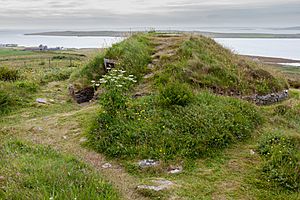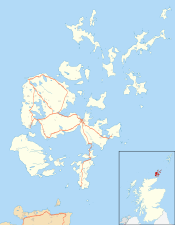Taversöe Tuick facts for kids

Exterior
|
|
| Alternative name | Taversoe Tuick |
|---|---|
| Location | Orkney |
| Coordinates | 59°07′52″N 3°00′18″W / 59.131°N 3.005°W |
| Type | Chambered cairn |
| History | |
| Periods | Neolithic |
Taversöe Tuick (also called Taversoe Tuick) is a very old stone structure on Rousay, an island in Orkney, Scotland. It's a special type of burial cairn, which is a mound of stones built over a burial place. This amazing monument was built during the Neolithic period, also known as the New Stone Age. This was a long time ago, between 4000 and 2500 BCE.
Taversöe Tuick is famous for its unique design. It has two main rooms, or "chambers," stacked one on top of the other. Imagine a secret underground room with another room built right above it!
Contents
Discovering Taversöe Tuick
This ancient site is a fantastic example of how people lived and buried their dead thousands of years ago. It helps us understand the history of the Neolithic people in Scotland.
What is a Burial Cairn?
A burial cairn is like a very old tomb made of stones. People in the past used them to bury important members of their community. These cairns often held the remains of many people.
Exploring the Chambers
Taversöe Tuick has a very unusual layout. It has an upper chamber that you can reach through a passage. Below it is a lower chamber, which is underground. Originally, these two rooms were separate. Today, you can go down a modern ladder from the upper room to reach the lower one.
No one knows exactly why the chambers were built one on top of the other. It's a mystery that archaeologists are still trying to solve! There's also a third, smaller chamber slightly downhill from the lower one. It's connected by a small channel. Some people thought it was a drain, but that's probably not its real purpose.
Uncovering the Past: Excavations
People first started exploring Taversöe Tuick a long time ago.
Early Discoveries
In 1898, archaeologists began digging at the site. They uncovered part of the upper chamber. During this work, they also found a way to get into the lower chamber, which was still untouched!
Full Excavation in 1937
The site was fully dug up and studied in 1937. At that time, a domed roof was added to protect the upper chamber. This roof helps keep the ancient structure safe from the weather.
Amazing Finds
During the excavations, archaeologists found many interesting things. They discovered several human skeletons and bones from people who had been cremated (burned). They also found bowls, a mace-head (a type of stone weapon or tool), a flint arrowhead, and scrapers (tools for preparing animal hides). Small beads made from shale (a type of rock) were also found. These items tell us a lot about the people who lived here so long ago.
Visiting Taversöe Tuick
Today, Taversöe Tuick is a scheduled monument. This means it's a very important historical site that is protected by law. It is looked after by Historic Environment Scotland, an organization that cares for Scotland's historic places.
The monument and its chambers are open to the public. You can visit this incredible ancient site and explore its unique double-tiered chambers for yourself!


